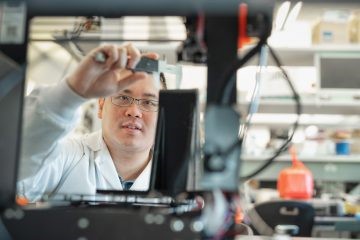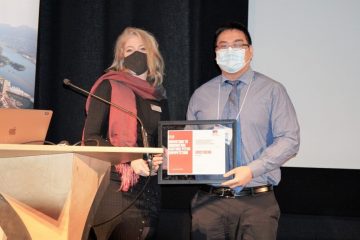Researchers from Dr. Karen Cheung’s lab are developing an innovative instrument that performs highly precise single cell isolation, to help other scientists with their whole genome sequencing applications.
Called Isolatrix, the instrument is a benchtop tool that quickly and accurately provides single cells to scientists in labs, accelerating the pace of their scientific work.
“Isolatrix can very precisely partition single cells for researchers in wet labs – at this point, we’re focusing on mostly human and mammalian cells,” said Eric Cheng, a PhD student and CBR member working on the project. He is part of the Biomedical and Microdevices (BioMEMS) Laboratory led by Dr. Karen Cheung.
Along with co-leads Dr. Adi Steif and Dr. Marco Mara, Dr. Cheung recently received Genome BC’s Pilot Innovation Fund to further develop the instrument. This new funding will bring the project to its next steps, with the goal of eventual commercialization.
An improved instrument to isolate single cells

Eric Cheng, PhD student
A major drive to understand single cells comes from cancer research. A tumour begins with a single, mutated cell that divides uncontrollably in the body. As the cancer grows, individual cells can mutate and change, leading to distinct cell subpopulations that could be more drug-resistant or spread faster than others. Although cancer has been traditionally studied as a “bulk” group of cells, understanding the disease on a single cell level could shed light on what makes specific subtypes of cells particularly deadly.
Isolatrix would help provide and dispense those single cells, so that researchers can analyze and sequence them in the lab. Using a glass inkjet nozzle, Isolatrix “prints” cells, which are then tracked by a camera that is directed by a machine learning algorithm. Through that algorithm, the instrument can very accurately identify when a single cell is isolated, and mark it for further analysis.
“Two strengths in our machine learning algorithm are accuracy and speed, which allow Isolatrix to very quickly and precisely mark single cells,” said Eric. While other instruments are available, many have the trade-off of being accurate but slow, or quick but imprecise.
“Two strengths in our machine learning algorithm are accuracy and speed, which allow Isolatrix to very quickly and precisely mark single cells.”
— Eric Cheng, BioMEMS Lab
Speed is especially important for a process as delicate as single cell isolation. When a cell gets stressed in its environment, its gene expression can change in a very short time frame, leading to later problems.
“We’ve spoken to researchers who’ve told us that if it takes hours to do the isolation step, the cell’s expression changes over the day, and by the time they can analyze the cell, they won’t be able to capture the information they were looking for,” said Eric. “We hope that Isolatrix can help bridge the gap between good speed and good accuracy.”
On the road to commercialization

Eric Cheng receiving his SFU I2I Venture Pitch award at SFU
As part of Genome BC’s funding, the Isolatrix team was assigned Dr. Steve Slater, CEO of Pluton Biosciences, as an industry mentor to help with commercialization. Eric has previously presented Isolatrix at two business venture pitch competitions: Invention to Innovation (I2I) at SFU, where he won in the Product Ready Venture category, and e@UBC Venture Showcase. He said those experiences provided critical feedback from business mentors, and were tremendously valuable in considering how to bring Isolatrix to market.
“Commercialization is so much more than just having a product that works well,” Eric said. “For example, we’re living through unprecedented times with COVID supply chain challenges, which we’ll also have to consider for Isolatrix. But business mentors can highlight hurdles like that, and make sure we’re not caught unawares.”
He said it’s been very rewarding to watch the project change and grow, from what started as an idea on a piece of paper to a real, functioning instrument in a lab. The project, which was previously supported with an NSERC I2I fund, will go into the next stages of genomic sequencing work with the new funding.
He said it’s been very rewarding to watch the project change and grow, from what started as an idea on a piece of paper to a real, functioning instrument in a lab.
He also emphasized the support of partners from varied backgrounds, in engineering and outside of it, who lent their expertise to the Isolatrix team. This includes Dr. Marco Mara and Dr. Adi Steif from genomics and bioinformatics backgrounds, as well as instrumentation expert Dr. Robin Coope.
“It’s incredible that the Genome Sciences Centre is right in our backyard – we actually installed a version of Isolatrix there last summer,” said Eric. “My lab’s background is engineering, but this project really can’t go forward without the domain expertise and support of our collaborators. Especially in such a new field like single cell analysis, having strong scientific partnerships is just essential.”
“The project has definitely been a journey, and there’s still a lot of work to be done,” he added. “But we’re really looking forward to seeing how Isolatrix makes an impact and helps accelerate science.”
If anyone is interested in learning more about the project or is interested in the single cell handling capabilities of the Isolatrix, please feel free to reach out to Eric at ericc@ece.ubc.ca.


